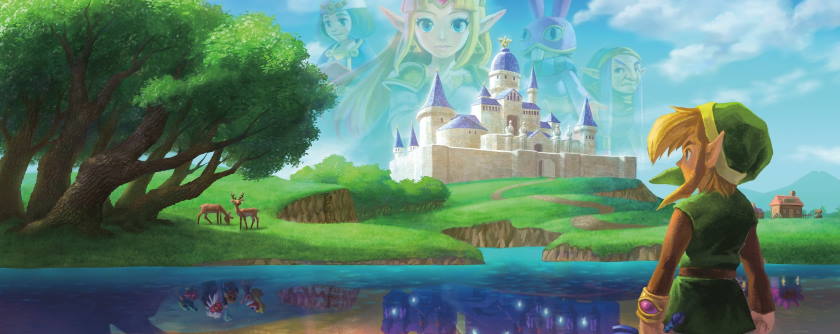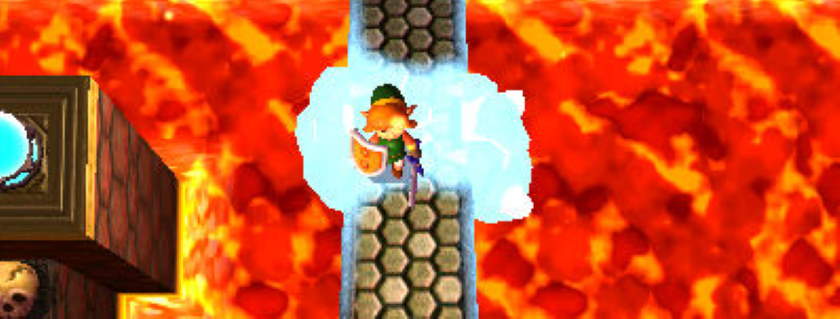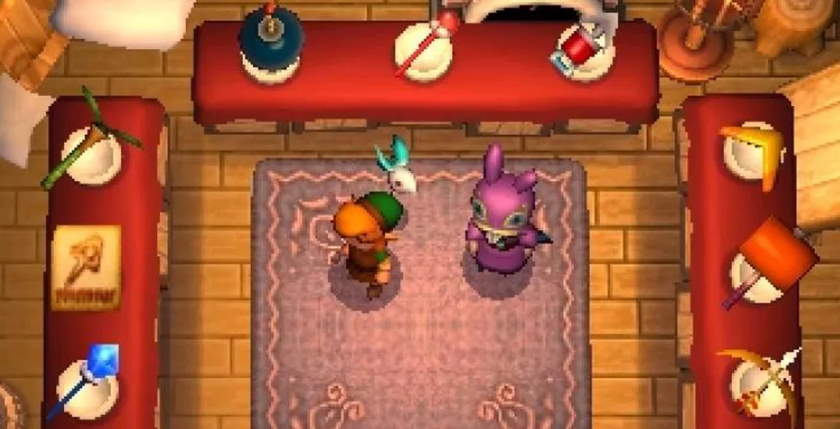Revisiting A Link Between Worlds

My response to A Link Between Worlds when it first released was unceasingly positive. Looking back at my initial write-up of the game, I had nothing but good things to say.
Which is why it’s so strange that I was not feeling nearly so warm about it on this recent playthrough.
Part of it may be due to having just played A Link to the Past before revisiting the 3DS sequel. I picked up the game again so that I might see where Nintendo took the concept some years later. If you watched my most recently released video, then you’ll know I spoke quite positively about that stormy, rain-drenched opening. It may honestly be my favorite opening of the entire franchise simply due to the tone it sets and the speed at which it gets the player into the middle of the action.
A Link Between Worlds opens with no such homage. It is far slower, taking cues from the latter Zelda games and their desire to establish a status quo before interrupting Hyrule’s peace. This means the same flaws that impact the “slow” or “easy” opening of A Link to the Past are made worse in A Link Between Worlds.
I don’t need every game to open up with action. However, I think some of the most memorable beginnings are those with a strong introductory gameplay segment. Final Fantasy VII has a classic opening not just because of the impressive 3D zoom-out and zoom-in of Midgar, but because the player is immediately hopping off of a train and fighting off enemy soldiers. Mega Man X begins on a highway with cars zooming away from the Maverick machines, pitting the player against monstrous helicopters that wreck the street in ways the prior games never tried.
Not to say that a calm, narrative-focused opening is always a problem. You simply need the writing chops to make it interesting, to invest the player in the experience enough that it will be worth revisiting on repeat playthroughs. Typically this is done by droppings bits of world-building that pay off later on, or hinting at later reveals that most players won’t think to be looking for on the first time through. A Link Between Worlds does no such thing. Its characters are shallow archetypes of every Zelda game, its twists hidden for the very end. While the colorful denizens of Hyrule certainly add some beneficial flavor to the game, they do little more than suck up time at the start as an obscene amount of text scrawls across the screen.
Really, though, what A Link Between Worlds attempts with story is a minor fraction of the experience. At most it made it harder to really get into the swing of things, the play sessions obnoxiously brief before I finally was able to sit down and feel invested in the game itself.
It is in the design of Hyrule and Lorule that I began to hit my next major stumbling block. Jumping out of A Link to the Past so swiftly and simultaneously leaping into Ocarina of Time, there was a clear shift felt in the design of dungeons in A Link Between Worlds. It was something that just left me scratching my head for a while, trying to understand why this new world felt less… immersive, I suppose.
It’s not a word I use often as I don’t know if I feel immersed in the way others use the word. I think of “immersive” as meaning a degree of believability in the world. It’s the sort of desire from a game that causes over-paid pundits to criticize a game for using such “video gamey” elements as puzzles. Activities that focus first on engaging rather than depicting a realistic environment.
I don’t care for realism in my games or if they include “video gamey” elements, so long as the game manages to engage me. Yet there was something about A Link Between Worlds that revealed its seams far more than the older Zelda titles that preceded it.

I cannot recall any other dungeon that made such use of the Ice Rod. Not enough to have made a significant impact, at least.
That something, I think, is modern Nintendo. Games like Super Mario 3D Land and Super Mario 3D World have themed “worlds”, but the levels within those worlds don’t rarely match the established aesthetic. They follow separate environmental “templates” that more or less indicate what sort of level you’ll be playing. While the Mario games have always gone for a variety of environment types in their levels – Super Mario World has at least one Ghost House, Switch Palace, underwater level, or underground level per world after the first – that sense of “cohesion” to the world is gone. You’re not going to run into a place like “Vanilla Dome” where the majority of maps are subterranean, or a world like the first of Donkey Kong Country 2 where nearly each level is pirate-ship themed.
While I love the single-player maps of a game like Splatoon, they are all very clearly separate obstacle courses whose only sense of cohesion comes from the skybox. It is perhaps for this reason that I’ve had such difficulty with completing the Octo Expansion. While I do not need to complete all 80 levels, it is still something I’d like to attempt. The problem is that I find it difficult to be enthused when each map looks roughly the same, just with a different arrangement of separate puzzles and obstacles.
Captain Toad: Treasure Tracker is, as wonderful a game as it is, perhaps best represents this approach Nintendo has developed. Every map is a puzzle diorama. While each map builds upon prior mechanics to increase the challenge and remix obstacles, each map could just as easily exist in a vacuum. There is nothing to thematically or contextually tie them together aside from the sequence in which you play them.
They feel like separate entities rather than part of a greater whole.
By necessity, the world and dungeons of A Link Between Worlds are built to look as if they’re part of one greater whole. However, Nintendo’s playbox design philosophy has even impacted this handheld sequel. It’s just best disguised when the player is wandering the overworld of Hyrule, the only location that delivers on the game’s promise of freedom.
It is true that the player can complete the dungeons in any order they choose due to a constant availability of equipment. From the game’s beginning the player can rent or purchase some of the most common tools from throughout the franchise – in addition to some new ones no doubt intended to help justify the glasses-free 3D of the handheld device. This allows Link to enter any dungeon on the world map in any order. This is especially true in Lorule, A Link Between Worlds’ version of the Dark World. It was welcomed as a major improvement at the time, a seeming shift in the formula made popular in the 90’s. In hindsight, the open-ended options experienced players can discover in A Link to the Past are now a built-in part of the game.

From very early on players have access to the entire arsenal. A promising concept that is never fulfilled.
The problem is that Lorule itself is incredibly segregated, each zone surrounding a dungeon separated apart from the rest of the world. Once you are in a portion of Lorule’s map, you are locked into that region unless you use the fast travel to another zone’s save point or return to Hyrule to discover the neighboring region’s gateway.
As warping can only be done through these gateways – rifts found within walls in each realm – the player’s freedom of exploration between dimensions is actually further inhibited. While travel from Hyrule to the Dark World was always limited to discovering warp tiles in A Link to the Past, the Magic Mirror allowed the player to return to the Light World from any location inside the Dark World. This meant that there were a handful of puzzles that relied on the player being observant or knowledgeable of the world map, warping into Hyrule in hopes of making a discovery. There was enough freedom that the player felt clever for uncovering the clues, no matter how obviously they were telegraphed.
In A Link Between Worlds, it’s largely just a matter of finding a rift and, on occasion, knowing whether to enter from the left or the right. Discovery is limited to seeing a bright, shining warp point. There does not need to be any recognition or memory of the counterpart Light World topography.
Furthermore, this means the player can now approach each piece of the world map as its own separate level. You have clear borders of exploration, wandering that region before taking a leap into that region’s dungeon.
Which was perhaps my greatest disappointment. Despite the player carrying a whole arsenal of tools, I actually found the majority of them to be lacking in versatility. Experiments to test how many weapons or tools could be used on different bosses was met with extreme rigid insistence on the dungeon’s designated tool. Whereas the Helmasaur in A Link to the Past could have his mask shattered by bombs or the hammer, the equivalent Dark Palace monster in A Link Between Worlds can only be damaged by bombs. The lamp and the bombs were the “designated tools” for that dungeon, and therefore the player was restricted to only using those within that dungeon. The hammer made no impact, despite being capable of crushing boulders.

Just as with all the newer Zelda games, the player is restricted to defeating bosses in one way only.
It’s a concession to the possibility that players may not have enough skill to avoid death, losing their rented items each time. While rupees are more numerous than ever, it’s very easy to lose them if you are repeatedly dying. Items are also exponentially more expensive to purchase so that they are kept even after death. It’s an attempt to balance challenge and difficulty, yet it so clearly clashes with the desire for freedom.
In essence, Nintendo never wanted to require the player use all of the items as it could be viewed as an expensive punishment for less capable players. Therefore, each dungeon is still limited to one-or-two prioritized items.
A Link to the Past comparatively feels as if it puts its many tools to better use. Though the hookshot isn’t necessarily required for the Ice Palace, it most certainly makes it easier to complete. The sliding penguin foes can be slain in a single strike with the hookshot, and all momentum on the slippery ice is halted by its use. Both the bombs and the fire rod feature heavily in the Ice Palace as well, and should the player manage to obtain the Cape then they’ll be able to pass by some of the more irritating, difficult rooms without a scratch.
Which leads me back to that “playbox” or “diorama” style of design. Like each level in Captain Toad, each dungeon in A Link Between Worlds feels as if it was developed in a vacuum. Even if the player can approach dungeons out of order in A Link to the Past, there’s typically a cost-benefit analysis to be made. To tackle the Ice Palace without the fire wand from Skull Palace or the hookshot from the Water Palace is to face greater hardship, though at the advantage of obtaining the Blue Mail earlier. In other words, those other dungeons impact later dungeons and therefore contribute to that sense of cohesion.
I once thought A Link Between Worlds indicated a bright future for where the Zelda franchise was going, but I now feel that Nintendo’s stand-alone diorama approach to level design results in… well, certainly a fun game, but one in which the seams are more clear. They don’t feel like “dungeons”, as much as a Zelda game ever gave such an impression. They feel like isolated playsets. Ironically, the predictable frustration of each dungeon relying on its key treasure was not only retained, but actively sabotaged the game’s freedom.

This optional dungeon is the only one that implements the hookshot in such a manner until the final dungeon. There are no dungeons that, say, combine this functionality with the Ice or Tornado Rods to navigate a dungeon.
Oddly enough, Breath of the Wild manages to pull off this level of freedom far better, though largely because it feels so unlike the preceding entries of the franchise. Though it was the Link to the Past aesthetic that pulled me in, I now believe A Link Between Worlds was hindered by trying to fix a template never intended for a more open-ended design.
Breath of the Wild, on the other hand, is an open world, and it relies on far fewer tools in order to complete puzzles. Shrines are brief brain-bending exercises rather than time-consuming dungeons. Each Divine Beast makes use of every tool the player carries rather than just a handful. There’s no concern in losing the necessary tools upon death, allowing the designers freedom to implement any tool they so desire. Despite the recycled assets and same obvious “stand-alone diorama” approach of the shrines, the open-world nature of the game makes it far easier to feel as if they remain in that cohesive world.
I will still likely replay A Link Between Worlds in the future. I enjoyed it, and it is most certainly a good game. However, I was shocked to find myself enjoying it less than the recently released Link’s Awakening.
It’s a fine game, but it feels far more like a Legend of Zelda product than experience. An odd, imprecise way to capture the difference between games, but it’s the best descriptor I have.


